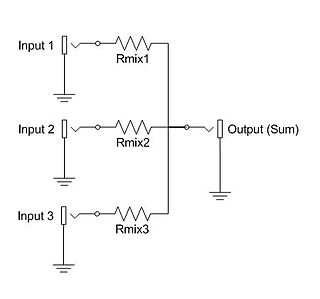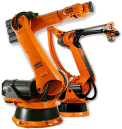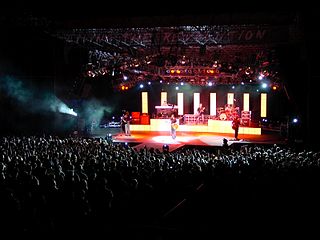 W
WAudio mixing is the process by which multiple sounds are combined into one or more channels. In the process, a source's volume level, frequency content, dynamics, and panoramic position are manipulated or enhanced. This practical, aesthetic, or otherwise creative treatment is done in order to produce a finished version that is appealing to listeners.
 W
WIn sound recording and reproduction, audio mixing is the process of optimizing and combining multitrack recordings into a final mono, stereo or surround sound product. In the process of combining the separate tracks, their relative levels are adjusted and balanced and various processes such as equalization and compression are commonly applied to individual tracks, groups of tracks, and the overall mix. In stereo and surround sound mixing, the placement of the tracks within the stereo field are adjusted and balanced. Audio mixing techniques and approaches vary widely and have a significant influence on the final product.
 W
WAn automixer, or automatic microphone mixer, is a live sound mixing device that automatically reduces the strength of a microphone's audio signal when it is not being used. Automixers lower the hiss, rumble, reverberation and other extraneous noise that occur when several microphones operate simultaneously.
 W
WBeatmatching or pitch cue is a disc jockey technique of pitch shifting or timestretching an upcoming track to match its tempo to that of the currently playing track, and to adjust them such that the beats are synchronised — e.g. the kicks and snares in two house records hit at the same time when both records are played simultaneously. Beatmatching is a component of beatmixing which employs beatmatching combined with equalization, attention to phrasing and track selection in an attempt to make a single mix that flows together and has a good structure.
 W
WTo cue audio is to determine the desired initial playback point in a piece of recorded music. It is a technique often used in radio broadcasting and DJing. One dictionary definition is to "Set a piece of audio or video equipment in readiness to play ."
 W
WIn professional audio, a digital mixing console (DMC) is an electronic device used to combine, route, and change the dynamics, equalization and other properties of multiple audio input signals, using digital signal processing rather than analog circuitry. The digital audio samples, which is the internal representation of the analog inputs, are summed to what is known as a master channel to produce a combined output. A professional digital mixing console is a dedicated desk or control surface produced exclusively for the task and is typically more robust in terms of user control, processing power and quality of audio effects. However, a computer can also perform the same function since it can mimic its interface, input and output.
 W
WA disc jockey, more commonly abbreviated as DJ, is a person who plays recorded music for an audience. Most common types of DJs include radio DJs, club DJs, mobile DJs, and turntablists. Originally, the "disc" in "disc jockey" referred to shellac and later vinyl records, but nowadays DJ is used as an all-encompassing term to also describe persons who mix music from other recording media such as cassettes, CDs or digital audio files on a CDJ, controller, or even a laptop. DJs may adopt the title "DJ" in front of their real names, adopted pseudonyms, or stage names.
 W
WA DJ mixer is a type of audio mixing console used by Disc jockeys (DJs) to control and manipulate multiple audio signals. Some DJs use the mixer to make seamless transitions from one song to another when they are playing records at a dance club. Hip hop DJs and turntablists use the DJ mixer to play record players like a musical instrument and create new sounds. DJs in the disco, house music, electronic dance music and other dance-oriented genres use the mixer to make smooth transitions between different sound recordings as they are playing. The sources are typically record turntables, compact cassettes, CDJs, or DJ software on a laptop. DJ mixers allow the DJ to use headphones to preview the next song before playing it to the audience. Most low- to mid-priced DJ mixers can only accommodate two turntables or CD players, but some mixers can accommodate up to four turntables or CD players. DJs and turntablists in hip hop music and nu metal use DJ mixers to create beats, loops and "scratching" sound effects.
 W
WAn electronic mixer is a device that combines two or more electrical or electronic signals into one or two composite output signals. There are two basic circuits that both use the term mixer, but they are very different types of circuits: additive mixers and multiplicative mixers. Additive mixers are also known as "analog adders" to distinguish from the related digital adder circuits.
 W
WIn audio engineering, a fade is a gradual increase or decrease in the level of an audio signal. The term can also be used for film cinematography or theatre lighting in much the same way.
 W
WLegitmix was a Canadian company that offered services to artists who create remixes. The company launched in 2011 and had offices in Ottawa, Ontario, Canada and Brooklyn, New York.
 W
WLive sound mixing is the blending of multiple sound sources by an audio engineer using a mixing console or software. Sounds that are mixed include those from instruments and voices which are picked up by microphones and pre-recorded material, such as songs on CD or a digital audio player. Individual sources are typically equalised to adjust the bass and treble response and routed to effect processors to ultimately be amplified and reproduced via a loudspeaker system. The live sound engineer listens and balances the various audio sources in a way that best suits the needs of the event.
 W
WIn the product line of the professional audio equipment brand Mackie, the 1604-VLZ Pro is a compact analog mixer. It features sixteen input channels, four output sub-groups, and a user-replaceable fuse. Each of the input channels features a high-quality microphone preamplifier.
 W
WA matrix mixer is an audio electronics device that routes multiple input audio signals to multiple outputs. It usually employs level controls such as potentiometers to determine how much of each input is going to each output, and it can incorporate simple on/off assignment buttons. The number of individual controls is at least the number of inputs multiplied by the number of outputs.
 W
WMetropolis Group is a music production and entertainment industry company established in 1989 by Gary Langan, Carey Taylor and Karin Clayton. It is located in the Powerhouse, a Grade II listed building, at 70 Chiswick High Road in Chiswick, London, England. Over the last twenty years the group has expanded and now consists of three divisions: Metropolis Studios, Metropolis Mastering, and Digital Media/Productions.
 W
WIn music recording, mix automation allows the console to remember the audio engineer's adjustment of faders during the post-production editing process. A timecode is necessary for the synchronization of automation. Modern mixing consoles and digital audio workstations use comprehensive mix automation.
 W
WIn sound recording and reproduction, and sound reinforcement systems, a mixing console is an electronic device for combining sounds of many different audio signals. Inputs to the console include microphones being used by singers and for picking up acoustic instruments, signals from electric or electronic instruments, or recorded music. Depending on the type, a mixer is able to control analog or digital signals. The modified signals are summed to produce the combined output signals, which can then be broadcast, amplified through a sound reinforcement system or recorded.
 W
WOdyssey Studios was a recording studio based near Marble Arch in London and opened in 1979. It was set up by Wayne Bickerton as an extension of State Records, the label he had set up with Tony Waddington and John Fruin in 1975. The studio closed in 1989 and the building was subsequently sold to Jazz FM.
 W
WA sound reinforcement system is the combination of microphones, signal processors, amplifiers, and loudspeakers in enclosures all controlled by a mixing console that makes live or pre-recorded sounds louder and may also distribute those sounds to a larger or more distant audience. In many situations, a sound reinforcement system is also used to enhance or alter the sound of the sources on the stage, typically by using electronic effects, such as reverb, as opposed to simply amplifying the sources unaltered.
 W
WStem-mixing is a method of mixing audio material based on creating groups of audio tracks and processing them separately prior to combining them into a final master mix. Stems are also sometimes referred to as submixes, subgroups, or buses.